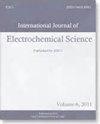将 2-乙氧基-4-(环氧乙烷-2-基甲基)苯酚作为 C38 钢潜在有效防腐剂的研究
IF 1.3
4区 化学
Q4 ELECTROCHEMISTRY
International Journal of Electrochemical Science
Pub Date : 2024-10-29
DOI:10.1016/j.ijoes.2024.100816
引用次数: 0
摘要
本文章由计算机程序翻译,如有差异,请以英文原文为准。
Investigation of 2-ethoxy-4-(oxiran-2-ylmethyl)phenol as a potentially effective anti-corrosion agent for C38 steel
This study presents a comprehensive investigation into the corrosion inhibition efficacy of the compound, 2-ethoxy-4-(oxiran-2-ylmethyl) phenol (EP), on C38 steel surfaces exposed to a highly corrosive 1 M HCl environment. Through a unique integration of experimental techniques—Electrochemical Impedance Spectroscopy (EIS), Potentiodynamic Polarization (PDP), Weight Loss (WL), Scanning Transmission Electron Microscopy coupled with X-ray Energy Dispersive Spectroscopy (STEM/XEDS)—and advanced theoretical methods, including Quantum Chemical Calculations (QCCs), Density Functional Theory (DFT), and Monte Carlo simulations (MCs), the study provides a deep and novel understanding of EP's corrosion inhibition mechanism. The findings reveal that EP acts as a mixed-type inhibitor, achieving a remarkable corrosion inhibition efficiency of approximately 92 % at 298 K by forming a protective layer on the steel surface. Notably, the adsorption of EP is characterized by both physisorption and chemisorption, adhering to the Langmuir isotherm model, a dual-mode mechanism that has been underexplored in similar compounds. The synergy between experimental data and theoretical simulations, particularly the use of DFT and MD simulations, elucidates the molecular interactions and adsorption behaviors that are critical to EP's effectiveness. This novel approach not only confirms EP's potential as a high-performance corrosion inhibitor but also contributes significant insights into the factors that govern corrosion inhibition, advancing the field's understanding of inhibitor design and application.
求助全文
通过发布文献求助,成功后即可免费获取论文全文。
去求助
来源期刊
CiteScore
3.00
自引率
20.00%
发文量
714
审稿时长
2.6 months
期刊介绍:
International Journal of Electrochemical Science is a peer-reviewed, open access journal that publishes original research articles, short communications as well as review articles in all areas of electrochemistry: Scope - Theoretical and Computational Electrochemistry - Processes on Electrodes - Electroanalytical Chemistry and Sensor Science - Corrosion - Electrochemical Energy Conversion and Storage - Electrochemical Engineering - Coatings - Electrochemical Synthesis - Bioelectrochemistry - Molecular Electrochemistry

 求助内容:
求助内容: 应助结果提醒方式:
应助结果提醒方式:


